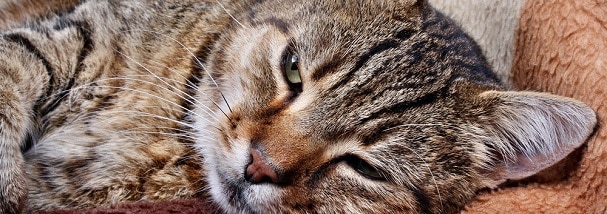 Crossbreed cats in the UK have an average life expectancy of 14 years, this is significantly longer than some breeds of dog. The first thing to remember is that age is not a disease. If your beloved pet is slowing down, or losing weight or acting strangely, it might not be just because they are getting older. Generally, cats over the age of 8-10 years are regarded as “senior” this means we could have a whopping 6 years + of caring for a “senior” pet.
Crossbreed cats in the UK have an average life expectancy of 14 years, this is significantly longer than some breeds of dog. The first thing to remember is that age is not a disease. If your beloved pet is slowing down, or losing weight or acting strangely, it might not be just because they are getting older. Generally, cats over the age of 8-10 years are regarded as “senior” this means we could have a whopping 6 years + of caring for a “senior” pet.
Taking any cat to the vets can be a daunting experience, especially those who are older. It is very important for the older cats to have regular health checks to help early diagnosis of common conditions which can improve prognosis and help create a better quality of life.
1. Hyperthyroidism
Hyperthyroidism is where the thyroid gland is overactive and producing excessive amounts of thyroid hormone. Hyperthyroidism is common in cats in the UK with prevalence of 21%. This makes it one of the most common conditions affecting older cats. The excess thyroid hormone raises metabolic rate and can cause clinical signs such as weight loss, changes in appetite, increased thirst and urination, vomiting and diarrhoea. The thyroid hormone can also cause other changes which are not outwardly visible by exerting more pressure on the kidneys and the heart. Hyperthyroidism can be detected early by regular weight checks, as continued weight loss would raise concerns, and diagnosed by taking a blood sample.
There are many treatment options available for hyperthyroidism including medication, surgical management, dietary changes and radiotherapy. The type of therapy chosen depends on consultation with your veterinary surgeon and what would be most suitable for you and your cat.
2. Heart Disease
Heart disease can be very difficult to detect in cats at home. Sometimes there may be subtle changes such as breathing very quickly or tiring more easily but these signs are not always present. In consultation, a veterinary surgeon can listen to the heart and measure rate and rhythm. Abnormalities detected following this can include a change in the rate, an abnormal rhythm or a heart murmur. Heart murmurs are very common in cats and have a prevalence of up to 20%. Heart murmurs are not always linked to heart disease which can further complicate diagnosis. If a heart condition is suspected based on history and clinical signs it is important to screen for any other conditions present. Diagnosis of heart disease often requires x-rays, an ultrasound scan of the heart and sometimes a blood sample.
3. Arthritis
Arthritis is extremely common in older cats and often goes undiagnosed. Cats do not often give clear signs of being in pain with their joints which can make it difficult to detect. Signs that might be seen at home include; slowing down, not jumping up as much, or a change in favourite sleeping area. Diagnosis of arthritis may be reached in a clinical examination or with the use of x-rays. Arthritis can be managed well with pain relief giving a good quality of life in to their senior years.
4. Dental Disease
Dental disease is the most common condition affecting older cats. Cats with severe dental problems will often keep eating and not give away any obvious signs of pain. Dental disease is easy to detect in a clinical examination with a veterinary surgeon. It is important that dental disease is addressed early on to prevent it progressing. Pain associated with dental problems can be significant and relieving this will make a massive difference to the quality of life to an older cat.
5. Chronic Kidney Disease
At home cats with chronic kidney disease (CKD) might be losing weight and drinking or urinating more. Chronic kidney disease varies in severity from mild to severe. A diagnosis is reached by assessing a blood sample and a urine sample. Often CKD is easy to manage with cats by dietary changes and sometime additional medication. Good survival times are reported for cats with CKD, often living for years from the time of diagnosis.
6. Nutrition
Nutrition is something which often gets overlooked when thinking about health conditions in older cats. In any older cat, it is recommended to feed a high-quality diet designed for use in senior life stages. It is important to also not overfeed your cat. Obesity has significant health complications, it can worsen arthritis, increase the risk of developing diabetes by up to eight-fold and be seriously life limiting. A lot of vet clinics are more than happy to offer advice and guidance with weight loss and some even offer free weight clinics.
7. Diabetes
Diabetes in cats is often Type-2 Diabetes which is due to insulin resistance. This is more common in Burmese cats but obesity is a serious risk factor for developing diabetes in any cat. Commonly diabetic cats will be drinking a lot more, and may have serious complications which lead to vomiting and dehydration. If you have any of these concerns with your cat, please contact your vets to make an appointment.
8. Lumps and Bumps
Lumps and bumps are more commonly found as any pet gets older. Lumps can either be due to inflammation, a benign tumour or a malignant tumour. Unfortunately, sometimes these lumps can represent cancerous growths. It is impossible to know exactly what a lump is just from looking at it. Therefore, it is important to get any lump or bump found on your pet checked out quickly so that it can be assessed by a veterinary surgeon. The veterinary surgeon may need to take samples from a lump to reach a diagnosis.
9. Hypertension
Hypertension is an increase in blood pressure beyond what is normal. Hypertension is sometimes seen alongside chronic kidney disease. The danger with high blood pressure is that it can seriously damage certain organs such as the brain and eyes. Sometimes this damage can be irreversible and lead to blindness. Blood pressure is something that can be easily measured at a health check and all you need to do is ask for it at you next health check with your veterinary surgeon. Hypertension is normally managed with medication.
10. Loss of senses
In normal daylight, a cat’s eyesight is poorer than that of a human but in low to dim lighting their eyesight is excellent. They also have highly sensitive hearing to help them detect threats or prey. A loss of eyesight has a huge impact on cats’ quality of life. Common causes include hypertension (see above), nuclear sclerosis and cataracts. These conditions can be detected in most health consultations with a veterinary surgeon. Common causes for a loss of hearing include ear infections and age related degeneration. Assessing a cats hearing can be very challenging so a diagnosis of deafness may not always be reached.
If you are worried about your old cat, please get in touch. All of us love cats but, did you know, our Surbiton clinic is especially Cat Friendly? Get in touch on 0208 390 5270.


